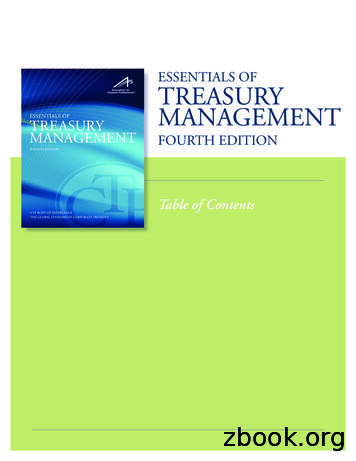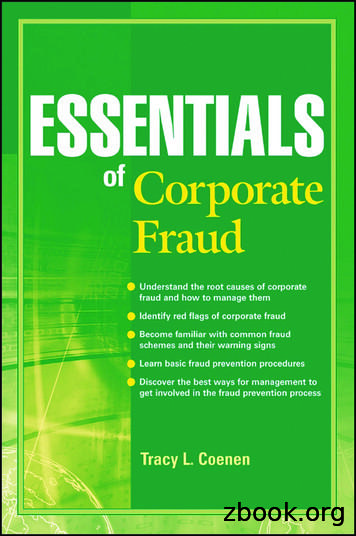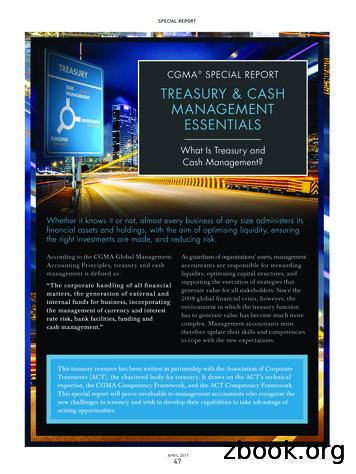ESSENTIALS OF TREASURY TrEasury MANAGEMENT
ESSENTIALS OFEssEntials oftrEasuryManagEMEntfourth EditionCtP Body of KnowlEdgEthE gloBal standard in CorPoratE trEasuryTREASURYMANAGEMENTFOURTH EDITIONTable of Contents
ESSENTIALS OFTREASURY MANAGEMENTFOURTH EDITIONTable of ContentsPART IPART IIIntroduction to the Study ofTreasury ManagementThe Treasury ManagementEnvironmentINTRODUCTIONCHAPTER 2:I. IntroductionREGULATORY AND LEGALENVIRONMENTII. The Evolving Role of the TreasuryProfessionalIII. Organization of Essentials of TreasuryManagementIV. SummaryCHAPTER 1:THE ROLE OF TREASURYMANAGEMENTI.IntroductionII. The Role and Organization of TreasuryManagementA. Overall Goal and ObjectivesB. T reasury Operations/Cash ManagementC. Bank Relationship ManagementD. R eporting and Information SharingIII. Finance and Treasury OrganizationA. F inancial Professionals in an OrganizationB. Treasury Organizational StructureIV. Corporate GovernanceA. T he Challenges of CorporateGovernanceB. R ole of the Board of Directors in TreasuryOperationsC. Role of Independent DirectorsV. SummaryI. IntroductionII. General Regulatory EnvironmentA. General Types of Financial Institution (FI)RegulationsB. Issues Affecting Financial RegulationIII. Primary Regulators and Standard Settersof Global Financial MarketsA. Central BanksB. Financial Stability Board (FSB)C. Bank for International Settlements (BIS)D. Basel Committee on Banking Supervision(BCBS)E. European Payments Council (EPC) andSEPAF. E uropean Securities and MarketsAuthority (ESMA)G. International Association of DepositInsurers (IADI)H. International Organization of SecuritiesCommissions (IOSCO)I. Financial Action Task Force (FATF)J. International Association of InsuranceSupervisors (IAIS)IV. U.S. Legal and Regulatory EnvironmentA. Regulatory AgenciesB. U.S. Legal Environment1
ESSENTIALS OFTREASURY MANAGEMENTFOURTH EDITIONTable of ContentsV. Tax ConsiderationsA. Unitary Taxes and Foreign Tax CreditsB. Capital TaxC. Asset Tax and Turnover TaxD. Withholding TaxE. Sales and Use TaxF. Other TaxesVI. Bankruptcy (Insolvency) LawsA. C ritical Issues in a Business BankruptcyDecisionB. Bondholders’ RightsC. Shareholders’ RightsD. Types of Bankruptcy in the U.S.E. F ormal versus Informal BankruptcyProceduresVII. SummaryAppendix 2.1: SEPA Member StatesCHAPTER 3:BANKS AND FINANCIALINSTITUTIONSI. IntroductionII. Financial Institutions: Functions andServicesA. Global FIsB. Commercial BanksC. Investment Banks and Brokerage FirmsD. Credit UnionsE. Special Purpose Financial InstitutionsIII. SummaryCHAPTER 4:PAYMENT SYSTEMSI. IntroductionII. Payment Systems OverviewA. Basic PaymentsB. The Payment ProcessC. Settlement versus FinalityD. Types of PaymentsIII. Cash PaymentsIV. Check-Based PaymentsA. On-Us Check ClearingB. Transit Check ClearingC. Foreign ChecksD. EndpointsE. Deadlines and Deposit TimingF. Availability SchedulesG. Balances and FloatH. Other Check-Processing Factors ThatInfluence AvailabilityI. Additional Paper-Based InstrumentsV. Large-Value Electronic Funds Transfer(EFT)/Wire Transfer SystemsA. Real-Time Gross Settlement (RTGS)SystemsB. Clearing House Interbank PaymentsSystem (CHIPS)C. TARGET2 and the Single Euro PaymentsArea (SEPA)D. Continuous Linked Settlement (CLS)E. Society for Worldwide Interbank FinancialTelecommunication (SWIFT)2
ESSENTIALS OFTREASURY MANAGEMENTFOURTH EDITIONTable of ContentsVI. Small-Value Transfer or AutomatedClearinghouse (ACH) SystemsCHAPTER 6:CAPITAL MARKETSVII. Card-Based Payment SystemsA. Credit CardsB. Debit Cards/EFTPOSC. Other Varieties of Payment CardsD. P ayment Card Industry Data SecurityStandard (PCI DSS)E. Merchant Card FeesI.VIII. SummaryCHAPTER 5:MONEY MARKETSI.IntroductionII. Global Money MarketsA. Money Market ParticipantsB. Investment Risk ConsiderationsC. T ypes of Money Market Instruments andInvestmentsIII. Short-Term Money Markets in theUnited StatesA. P rocessing and Clearing of Short-TermInvestments in the U.S.B. U.S. Money Market ParticipantsC. U .S. Federal Agency and GovernmentSponsored Enterprise (GSE) SecuritiesD. M unicipal Notes, Variable Rate DemandObligations (VRDOs) and Tax-ExemptCommercial Paper (CP)IV. SummaryIntroductionII. Overview of Capital MarketsA. The BasicsB. Key ParticipantsC. Division of the Capital MarketsD. Security Exchanges and Over-theCounter (OTC) MarketsIII. Debt MarketA. Medium- and Long-Term BorrowingB. Other Factors in Using Debt as a Sourceof CapitalIV. Equity (Stock) SecuritiesA. Common StockB. Preferred StockC. Hybrid SecuritiesD. Depositary Receipts (DRs)V. SummaryAppendix 6.1: Listing of the World’s Top 10Stock ExchangesCHAPTER 7:RELATIONSHIP MANAGEMENTAND VENDOR SELECTIONI.IntroductionII. Relationship ManagementA. Number of Bank RelationshipsB. DocumentationC. Performance Measurement andEvaluation3
ESSENTIALS OFTREASURY MANAGEMENTFOURTH EDITIONTable of ContentsIII. Vendor Selection and the Request forProposal (RFP) ProcessA. Getting StartedB. RFP DesignC. RFP AdministrationIV. Bank Compensation PracticesA. Billing for Bank ServicesB. Value DatingC. A ccount Analysis in the US CommercialBanking SystemD. Comparing and Monitoring Costs amongFinancial Services ProvidersV. Assessing Service Provider RiskA. A ssessing Operational Risk for ServiceProvidersB. A ssessing Financial Services Provider (FSP)RiskC. Sovereign and Political RiskD. M anaging Confidential Information andConflicts of InterestE. Legal and Ethical IssuesVI. SummaryPART IIIWorking Capital ManagementCHAPTER 8:INTRODUCTION TO WORKINGCAPITAL MANAGEMENTI. IntroductionII. Overview of Working CapitalA. Operating Cash Flows and TimelinesB. FloatIII. The Working Capital Cash ConversionCycle (CCC)A. Days’ Inventory or Inventory ConversionPeriodB. Days’ Receivables or ReceivablesConversion PeriodC. Days’ Payables or Payables ConversionPeriodD. Calculating the Cash Conversion Cycle(CCC)E. Evaluating the Impact of Changes to theCash Flow TimelineIV. How Changes in Current Accounts ImpactExternal FinancingA. Changes in Current AssetsB. Changes in Current LiabilitiesC. External Financing RequirementsV. Working Capital Investment and FinancingStrategiesA. Current Asset Investment StrategiesB. Current Asset Financing Strategies4
ESSENTIALS OFTREASURY MANAGEMENTFOURTH EDITIONTable of ContentsVI. Management of Credit and AccountsReceivable (A/R)A. R elationship Between Treasury andCredit ManagementB. Trade Credit PoliciesC. Billing and Collection MethodsD. Forms of Credit ExtensionE. Cash ApplicationF. Considerations Pertaining to Terms of SaleG. Financing Accounts Receivable (A/R)VII. Management of InventoryA. Elements of Basic Inventory PolicyB. Inventory Financing AlternativesVIII. Management of Accounts Payable (A/P)A. Disbursement System ConsiderationsB. Types of A/P and Disbursement SystemsIX. Multi-national Working CapitalManagement ToolsA. Multicurrency AccountsB. NettingC. Leading and LaggingD. Re-InvoicingE. Internal FactoringF. In-house BankingG. Export FinancingX. SummaryCHAPTER 9:WORKING CAPITAL METRICSI. IntroductionII. Basic Financial ConceptsA. Time Value of MoneyB. Opportunity CostC. Cost of CapitalIII. Fundamental Working Capital MetricsA. Current RatioB. Quick RatioC. Cash Flow to Total Debt RatioD. Total Working CapitalIV. Calculation of the Cash Conversion Cycle(CCC)A. Days’ Sales in Inventory (DSI)B. Days’ Receivables (DR)C. Days’ Payables (DP or DPO- Days’Payables Outstanding)D. Cash Conversion Cycle (CCC)E. Cash TurnoverF. Days of Working Capital (DWC)G. Cash Conversion EfficiencyV. Cash Discount CalculationsA. Costs to a Buyer of Not Taking the CashDiscountB. Financial Impact to a Seller of Offering aCash DiscountVI. Accounts Receivable (A/R) Monitoring andControlA. Days’ Sales Outstanding (DSO)B. Accounts Receivable (A/R) AgingScheduleC. Accounts Receivable (A/R) BalancePatternVII. Collections and Concentration CalculationsA. Lockbox Cost/Benefit AnalysisB. Cash Concentration Break-Even AnalysisVIII. Summary5
ESSENTIALS OFTREASURY MANAGEMENTFOURTH EDITIONTable of ContentsCHAPTER 10:COLLECTIONS, CONCENTRATION,AND DISBURSEMENTSI. IntroductionII. DisbursementsA. Disbursement Management ProductsB. Electronic Disbursement ProductsC. Card PaymentsD. O utsourced Accounts Payable (A/P)ServicesE. Managing Disbursement InformationIII. CollectionsA. Collecting PaymentsB. Domestic Collection ProductsC. C ross-Border Collections and TradeManagement ProductsIV. Concentration of FundsA. Domestic Concentration of FundsB. Global Concentration of FundsV. Payments FraudE. Securities Safekeeping and CustodyServicesF. Investment Risk ConsiderationsIII. Pricing and Yields on Short-TermInvestmentsA. Factors Influencing Investment PricingB. Yield Calculations for Short-TermInvestmentsIV. Managing Short-Term FinancingA. Short-Term Funding AlternativesB. Pricing and Costs of Principal Short-TermFinancing SourcesV. Debt FinancingA. Costs of BorrowingB. Basic Components of Interest RatesC. Base RatesD. Short-Term Versus Long-Term BorrowingE. Loan Agreements and CovenantsF. Credit Rating Agencies (CRAs)V. SummaryVI. SummaryAppendix 11A: Listing of Some Major CreditRating AgenciesCHAPTER 11:CHAPTER 12:SHORT-TERM INVESTING ANDBORROWINGLONG-TERM AND CAPITALINVESTMENTSI. IntroductionI. IntroductionII. Managing Short-Term InvestmentsA. I n-House vs. Outsourced Management ofShort-Term Investment PortfolioB. Short-Term Investment PoliciesC. Investment StrategiesD. ReportingII. Managing Capital Market InvestmentsA. Objectives of Capital Market InvestmentsB. The Asset Allocation DecisionC. Long-Term, Fixed-Income (Debt) PortfolioManagementD. Equity (Stock) Portfolio Management6
ESSENTIALS OFTREASURY MANAGEMENTFOURTH EDITIONTable of ContentsIII. Valuation of Long-Term SecuritiesA. Bond or Fixed-Income ValuationB. Preferred Stock ValuationC. Common Stock ValuationCHAPTER 14:IV. SummaryII. Information Technology for TreasuryA. The Role of Information Management inTreasuryB. Information SecurityC. Types of Information ManagementTechnology SolutionsD. Information Management TechnologyPlatformsE. Workflow ManagementF. Technology Policies and GuidelinesCHAPTER 13:CASH FORECASTINGI. IntroductionII. Purpose of Cash ForecastingIII. Issues and Opportunities in ForecastingA. SimplicityB. Collaboration and CommunicationC. DuplicationIV. Types of ForecastsA. PurposeB. Forecasting HorizonsC. Update FrequencyD. Projected Closing Cash PositionV. The Forecasting ProcessA. Cash Flow ComponentsB. Degree of CertaintyC. Data Identification and OrganizationD. S election and Validation of theForecasting MethodVI. Forecasting MethodsA. Short-Term Methods Forecasting MethodB. Medium and Long-Term ForecastingMethodsC. Statistical Methods in ForecastingINFORMATION TECHNOLOGY INTREASURYI. IntroductionIII. Treasury Management Systems (TMS)A. BackgroundB. FunctionalityC. Technology PlatformD. CostsIV. eCommerceA. Basics of eCommerceB. Electronic Data Interchange (EDI)C. eCommerce Communications StandardsD. Electronic Bank Account Management(eBAM)E. Mobile BankingV. SummaryVII. Best Practices of Cash ForecastingVIII. Summary7
ESSENTIALS OFTREASURY MANAGEMENTFOURTH EDITIONTable of ContentsPART IVRisk ManagementCHAPTER 15:OPERATIONAL AND ENTERPRISERISK MANAGEMENTI. IntroductionII. General Risk ManagementA. The Risk Management ProcessB. Techniques Used to Measure RiskC. Risk ProfileD. Risk Management Policy and GovernanceIII. Enterprise Risk Management (ERM)A. Market RiskB. Credit RiskC. Operational RiskD. Liquidity RiskE. Legal and Regulatory Compliance RiskF. Event RiskG. Business RiskH. Strategic RiskI. Reputation RiskIV. Operational Risk ManagementA. Internal Operational RisksB. External Operational RisksC. F undamental Factors for Operational RiskManagement StrategyV. Disaster Recovery and Business ContinuityA. D eveloping an Effective DisasterRecovery (DR) PlanB. Creating a Communication PlanC. Implementing the PlanD. Performing Periodic TestingVI. Insurance ManagementA. Using Insurance Contracts to ManageRiskB. Dealing with Insurance ProvidersC. Insurance Risk Management ServicesD. Risk-Financing TechniquesVII. SummaryCHAPTER 16:FINANCIAL RISK MANAGEMENTI. IntroductionII. Overview of Financial Risk Management inTreasuryA. Interest Rate RiskB. Foreign Exchange (FX) RiskC. Commodity Price RiskD. Managing Financial RiskE. The Benefits of Financial RiskManagementIII. Derivative Instruments Used as FinancialRisk Management ToolsA. ForwardsB. FuturesC. SwapsD. OptionsE. ComparisonIV. Foreign Exchange (FX) Risk Managementin TreasuryA. Challenges in International/GlobalTreasury ManagementB. Foreign Exchange (FX) RatesC. Emerging Markets8
ESSENTIALS OFTREASURY MANAGEMENTFOURTH EDITIONTable of ContentsV. Currency Derivatives Used to HedgeForeign Exchange (FX) ExposureA. C urrency or Foreign Exchange (FX)ForwardsB. Currency FuturesC. Currency SwapsD. Currency OptionsE. H edging Tools Available for ExoticCurrenciesVI. Interest Rate Exposure and RiskManagementA. Interest Rate ForwardsB. Interest Rate FuturesC. Interest Rate SwapsD. Interest Rate OptionsVII. Commodity Price ExposureVIII. O ther Issues Related to Financial RiskManagementA. Accounting IssuesB. Tax Issues Related to HedgingC. Hedging Policy StatementIX. SummaryCHAPTER 17:TREASURY POLICIES ANDPROCEDURESI. IntroductionII. Overview of Treasury Policies andProceduresA. T he Role of Treasury Policies andProceduresB. W hy Treasury Policies and Procedures AreNeededIII. Guidelines for Creating Policies andProceduresA. Key Control ConsiderationsB. Writing the PolicyC. Approval of the PolicyD. Policy Reviews, Updates, and RevisionsE. Procedure Development andImplementationIV. Policy Development Example: Short-TermInvestment PolicyA. The Importance of Having an InvestmentPolicyB. Setting Investment ObjectivesC. Developing a List of PermittedInvestmentsD. Investment RequirementsE. Other Issues in Developing an InvestmentPolicyV. Overview of Key Treasury PoliciesA. Bank Account and Financial ServicesAuthority PoliciesB. Payments PolicyC. Collection and Concentration PolicyD. Investment Valuation and ImpairmentPoliciesE. Payment Card PoliciesF. Outsourcing PolicyG. Financial Risk Management PoliciesH. Regulatory Compliance PoliciesI. Funding/Financing PoliciesJ. Treasury Systems PolicyVI. Summary9
ESSENTIALS OFTREASURY MANAGEMENTFOURTH EDITIONTable of ContentsPART IVCHAPTER 19:Financial ManagementFINANCIAL PLANNING ANDANALYSISCHAPTER 18:I. IntroductionFINANCIAL ACCOUNTING ANDREPORTINGI. IntroductionII. Accounting Concepts and StandardsA. Global Accounting StandardsB. IFRS Basic PrinciplesC. U.S. Accounting StandardsD. GAAP versus IFRSIII. Financial Reporting StatementsA. A uditing and Financial StatementReliabilityB. Types of Financial StatementsIV. Accounting for Derivatives, Hedges andForeign Exchange (FX) TranslationA. Derivatives and Hedge AccountingB. F oreign Exchange (FX) TranslationAccountingV. Accounting for U.S. Governmental andNot-For-Profit (G/NFP) OrganizationsVI. SummaryAppendix 18.1: Listing of Selected ASC TopicsII. Cost BehaviorA. Cost Types and BehaviorsB. Operating LeverageC. Economies of ScaleD. Financial LeverageIII. Decision EvaluationA. Identifying Relevant Costs and RevenuesB. Cost/Benefit AnalysisIV. Developing Operating and FinancialBudgetsA. Treasury’s Role in BudgetingB. Budgets and Financial PlansC. The Budgeting ProcessD. Uses of Budgets and Financial PlansV. Financial Statement AnalysisA. Common-Size Statements and RatiosB. Liquidity or Working Capital RatiosC. Efficiency or Asset Management RatiosD. Debt Management RatiosE. Performance RatiosF. Integrated Ratio AnalysisG. Service Industry RatiosH. Strengths and Limitations of RatioAnalysisVI. Performance MeasurementA. Return on Investment (ROI)B. Residual Income (RI)C. Free Cash Flow (FCF)D. Economic Value Added (EVA)10
ESSENTIALS OFTREASURY MANAGEMENTFOURTH EDITIONTable of ContentsVII. Financial Analysis and Rating AgenciesVIII. SummaryCHAPTER 20:FINANCIAL DECISIONS ANDMANAGEMENTI. IntroductionII. Capital Structure of a CompanyA. Optimal and Target Capital StructuresB. T rade-Offs Between Financing withLong-Term Debt and Common StockC. Capital Structure TheoryD. Business and Financial RiskE. Target Capital StructureF. O ther Considerations in the CapitalStructure DecisionG. Capital Structure in Not-For-ProfitOrganizationsVI. Equity Financing and ManagementA. Initial Public Offerings (IPOs) and theDecision to List Stock in the UnitedStatesB. Shareholder RightsC. Mergers and AcquisitionsD. At The Market (ATM) PlansVII. Other Topics in Financial DecisionsA. Tax StrategiesB. Dividend PolicyC. Repatriation of Capital for MultinationalCompanies (MNCs)D. Market Analysis and Research ToolsVIII. SummaryIII. Raising and Managing Long-Term CapitalA. Raising CapitalB. Managing Outstanding CapitalIV. Cost of Capital and Firm ValueA. Capital Components and CostsB. Cost of DebtC. Cost of Common EquityD. Weighted Average Cost of Capital (WACC)E. Firm ValueV. Lease Financing and ManagementA. Why Companies LeaseB. Types of LeasesC. Estimated Residual ValueD. Tax Considerations for LeasesE. Lease Versus Borrow to Buy Decision11
ESSENTIALS OF TREASURY MANAGEMENT FOURTH EDITION Table of Contents 5 VI. Management of Credit and Accounts Receivable (A/R) A. Relationship Between Treasury and Credit Management B. Trade Credit Policies C. Billing and Collection Methods D. Forms of Credit Extension E. Cash Application F. Considerations Pertaining to Terms of SaleFile Size: 355KB
Jun 30, 2019 · 11/15/2027 2.250 52,723,125 1/15/2021 2.000 47,618,750 2/15/2029 2.625 39,639,830 8/15/2023 6.250 37,584,680 u s treasury bond u s treasury note u s treasury note u s treasury note u s treasury note u s treasury note u s treasury note u s treasury note u s treasury bond us treas-cpi inflat 1/
Essentials of Knowledge Management,Bryan Bergeron Essentials of Patents,Andy Gibbs and Bob DeMatteis Essentials of Payroll Management and Accounting,Steven M.Bragg Essentials of Shared Services,Bryan Bergeron Essentials of Supply Chain Management,Michael Hugos Essentials of Trademarks and Unfair Competition,
Treasury Management and Ambit Retail Margining, banks can address all strategic, operational and risk management requirements of the treasury. KAREN A. HORCHER, ESSENTIALS OF MANAGING TREASURY. The treasury group is the financial center of an organization. The key role of treasury
Essentials of Financial Risk Management, Karen A. Horcher Essentials of Intellectual Property, Paul J. Lerner and Alexander I. Poltorak Essentials of Knowledge Management, Bryan Bergeron Essentials of Patents, Andy Gibbs and Bob DeMatteis Essentials of Payroll Management and Accounting, Steven M. Bragg
TREASURY & CASH MANAGEMENT ESSENTIALS What Is Treasury and Cash Management? PIAL RPR APRIL 2017 48 POSITIONING TREASURY AND CASH MANAGEMENT Every organisation deals with treasury issues, but many organisations do not have a distinct
Only activities related to topic areas found in Essentials of Treasury Management, Second Edition (e.g., treasury/cash management, finance, accounting, ethics, economics) are eligible for recertification credits. Treasury career development activities are also accepted but
Cybersecurity Essentials Introduction to Cybersecurity Introduction to IoT Networking Essentials Entrepreneurship Explore Introduction to exciting opportunities in technology. Preparation for entry level positions. Networking CCNP R&S: Switch Route TShoot Digital Essentials IT Essentials NDG Linux Essentials PCAP: Programming Essentials in Python
Solutions: AMC Prep for ACHS: Counting and Probability ACHS Math Competition Team 5 Jan 2009. Problem 1 What is the probability that a randomly drawn positive factor of 60 is less than 7? Problem 1 What is the probability that a randomly drawn positive factor of 60 is less than 7? The factors of 60 are 1,2,3,4,5,6,10,12,15,20,30, and 60. Six of the twelve factors are less than 7, so the .























